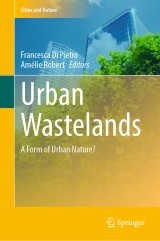Details

Urban Wastelands
A Form of Urban Nature?Cities and Nature
|
139,09 € |
|
| Verlag: | Springer |
| Format: | |
| Veröffentl.: | 18.10.2021 |
| ISBN/EAN: | 9783030748821 |
| Sprache: | englisch |
| Anzahl Seiten: | 367 |
Dieses eBook enthält ein Wasserzeichen.
Beschreibungen
<p>Faced with the growing demand for nature in cities, informal greenspaces are gaining the interest of various stakeholders - residents, associations, public authorities - as well as scientists. This book provides a cross-sectorial overview of the advantages and disadvantages of urban wastelands in meeting this social demand of urban nature, spanning from the social sciences and urban planning to ecology and soil sciences. It shows the potential of urban wastelands with respect to city dwellers’ well-being, environmental education, urban biodiversity and urban green networks as well as concerns regarding urban wastelands’ in relation to conflicts, and urban marketing. The authors provide a global insight through case studies in nine countries, mainly located in Europe, Asia and America, thus offering a broad perspective.</p>
PART I: Uses, rules and conflicts about nature in urban wastelands.- Chapter 1. The urban wasteland, spatial expression of a transition of uses: cross-media contributions art, ecology and geography (Cieslik).- Chapter 2. Recent developments in the legal framework of urban wastelands: to better take into account nature in the city (Chapouton).- Chapter 3. Dwelling in urban wastelands: a disputed nature (Mattoug).- Chapter 4. Between privatization and publicising, which place for nature in the frame of urban wastelands' reconversion? (Lotz).- Chapter 5. Long-standing wastelands: transactions, publicising Vs privatising and green settings on two urban wastelands in Tirana and Istanbul (Dorso & Muci).- PART II: Contaminated soils in urban wastelands.- Chapter 6. Ecological restoration of contaminated brownfield sites in urban areas: what perspectives in the context of European policies and national regulatory contexts? (Limasset).- Chapter 7. Social representations of nature regarding (soil-)contaminated brownfields in France (Tendero).- Chapter 8. Brownfield gardens and contaminated soils (Petit-Berghem).- PART III: Urban wastelands and waterfronts.- Chapter 9. Wastelands at city-port interfaces: the search of water spaces to evade urban tumults (Mazy).- Chapter 10. The requalification of urban riversides: environmental and social issues at stake (Carrière).- Chapter 11. Becoming wastelands: the captation areas of the traditional water management system of Tamil Nadu (India) (Verdelli).- PART IV: Wastelands in the urban green network.- Chapter 12. The conditions that make urban wastelands reservoirs of biodiversity for cities (Machon).- Chapter 13. Vacant lots' urban landscape and legacies: which influence on plant communities? (Brun).- Chapter 14. Generalised and temporary greening on deconstructed urban wastelands: an opportunity for biodiversity (Lemoine).- Chapter 15. Approaches to develop urban wastelands as elements of green infrastructure including the perception and use by residents (Mathey).- Chapter 16. How informal open spaces contribute to the metropolitan park system? The case of Brussels and its semi-naturals spaces (Vanbutsele).<p></p>
<p>As Associate Professor of Environmental Geography at the University of Tours (France), in the Planning & Environment Department, <b>Francesca Di Pietro </b>works on plant biodiversity in anthropogenic environments, at first in agricultural landscapes, later in urban ones. Her research focuses on plant communities of urban habitats such as public green spaces, urban wastelands, roadsides, community and individual gardens. Since 2011 she has worked on urban wastelands, coordinating work on their plant communities, informal uses, and how they are perceived.</p>
<p><b>Amélie Robert</b> is currently a contract researcher and part-time lecturer at the University of Tours. Her research focuses on landscape dynamics, the identification of their drivers and ecosystem services, from a geohistorical perspective. More generally, she questions the interrelationships between societies and their environments in different contexts. She pays special attention to novel ecosystems, particularly in urban contexts, having contributed to several research programs in this field.</p>
<p><b>Amélie Robert</b> is currently a contract researcher and part-time lecturer at the University of Tours. Her research focuses on landscape dynamics, the identification of their drivers and ecosystem services, from a geohistorical perspective. More generally, she questions the interrelationships between societies and their environments in different contexts. She pays special attention to novel ecosystems, particularly in urban contexts, having contributed to several research programs in this field.</p>
<p>Faced with the growing demand for nature in cities, informal greenspaces are gaining the interest of various stakeholders - residents, associations, public authorities - as well as scientists. This book provides a cross-sectorial overview of the advantages and disadvantages of urban wastelands in meeting this social demand of urban nature, spanning from the social sciences and urban planning to ecology and soil sciences. It shows the potential of urban wastelands with respect to city dwellers’ well-being, environmental education, urban biodiversity and urban green networks as well as concerns regarding urban wastelands’ in relation to conflicts, and urban marketing. The authors provide a global insight through case studies in nine countries, mainly located in Europe, Asia and America, thus offering a broad perspective.</p>
Topical and high-stakes issues of interest to both planners and citizens Cross-sectorial approach, spanning from social sciences and urban planning to ecology and soil sciences, with a focus on urban wastelands Global insights: studies from nine countries in Europe, Asia and America A special chapter dedicated to multidisciplinary approaches
Diese Produkte könnten Sie auch interessieren:

Observing Systems for Atmospheric Composition

von: Guido Visconti, Pietro Di Carlo, W. Brune, M. Schoeberl, Andreas Wahner

149,79 €















